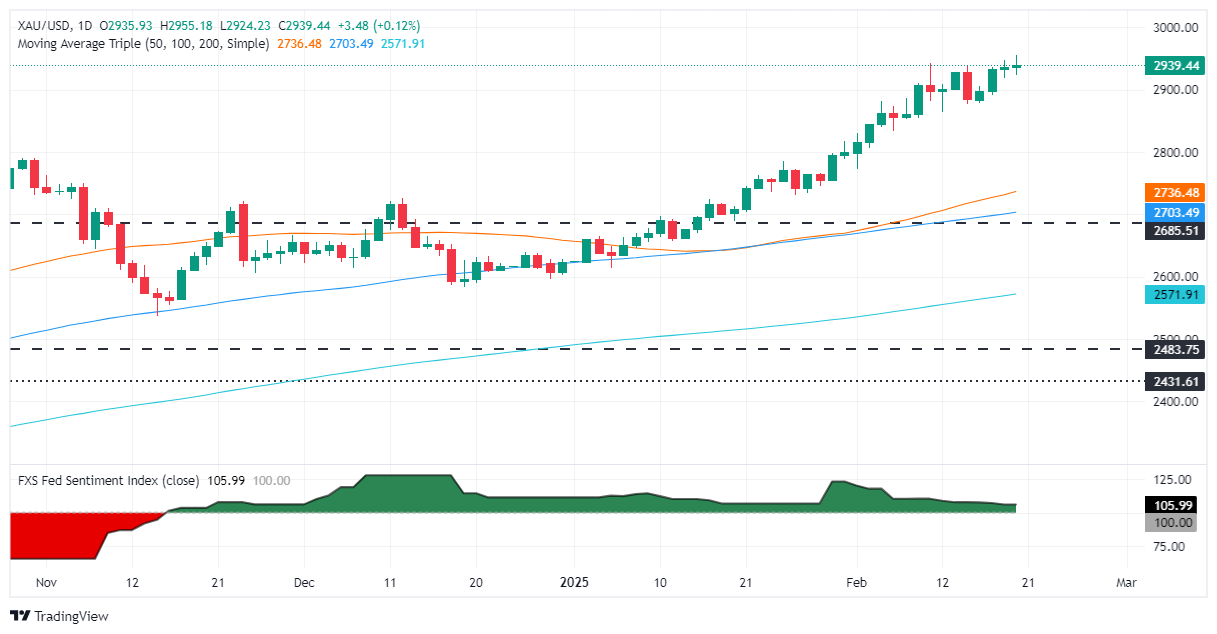Gold price extended gains on trade war fears, soft US Dollar
- Gold rises 0.23% as risk aversion fuels safe-haven flows.
- Fed Minutes highlight inflation concerns amid Trump’s trade policies.
- Traders eye S&P Global Flash PMIs for further market direction.
Gold's price advanced late in the North American session yet traded off record highs of $2,954 as traders took profits. Trade war woes, a weak US Dollar, and falling US Treasury bond yields kept XAU/USD trading with modest gains of 0.23% near the $2,939 mark at the time of writing.
Bullion’s demand remains fueled by uncertainty about global trade. Risk aversion sparked flows toward the safe-haven appeal of Gold alongside the Japanese Yen (JPY), which posted substantial gains during the day.
The Federal Reserve’s (Fed) Meeting Minutes from Wednesday revealed that Trump’s trade and immigration policies fueled concerns over rising prices. Hence, the Fed Chair Jerome Powell and Co. decided to hold rates unchanged at the January meeting as they assess the current economic data.
In the meantime, some Fed speakers crossed the wires and have turned slightly cautious. Atlanta Fed President Raphael Bostic sees two rate cuts this year and emphasizes that the economy is not facing a new burst of inflation. St. Louis Fed President Alberto Musalem sees some policy shifts and increased risks of inflation stalling above the Fed’s 2% goal.
Finally, Chicago’s Fed President Austan Goolsbee said that before the recent policy and geopolitical uncertainties, overall inflation "looked pretty good" and was down substantially. However, Trump's broad-based and higher tariffs currently in development keep the Fed nervous.
Data-wise, US job data was softer than expected as the number of Americans filling out unemployment benefits came below estimates. On Friday, Gold traders are eyeing the release of S&P Global Flash PMIs.
Daily digest market movers: Gold price boosted by Trump’s tariff threats fueling safe-haven demand
- US President Donald Trump recently announced that tariffs on cars, automobiles, and computer chips would be around 25%. He also said on Wednesday that duties would broaden to other commodities like lumber.
- US Initial Jobless Claims for the week ending February 15 increased by 219K, exceeding forecasts of 215K.
- The US 10-year Treasury bond yield falls three basis points (bps) and yields 4.505%.
- US real yields, which correlate inversely to Bullion prices, drop three basis points to 2.04%, a tailwind for Bullion prices.
- The World Gold Council revealed that central bank purchases rose more than 54% YoY to 333 tonnes following Trump’s victory, according to its data.
- Money market fed funds futures are pricing in 41.5 basis points of easing by the Fed in 2025.
XAU/USD technical outlook: Gold price faces stir resistance and retreats
Gold price uptrend remains intact, even though it has failed to decisively clear the $2,950 figure, opening the door for a pullback. Momentum shows overstretched as the Relative Strength Index (RSI) exited from overbought conditions, suggesting that sellers are gathering momentum.
In that outcome, the first support would be the February 14 swing low of $2,877, followed by the February 12 daily low of $2,864.
On the other hand, if XAU/USD rises past $2,954, the first resistance would be the psychological $2,950, followed by $3,000.

Gold FAQs
Gold has played a key role in human’s history as it has been widely used as a store of value and medium of exchange. Currently, apart from its shine and usage for jewelry, the precious metal is widely seen as a safe-haven asset, meaning that it is considered a good investment during turbulent times. Gold is also widely seen as a hedge against inflation and against depreciating currencies as it doesn’t rely on any specific issuer or government.
Central banks are the biggest Gold holders. In their aim to support their currencies in turbulent times, central banks tend to diversify their reserves and buy Gold to improve the perceived strength of the economy and the currency. High Gold reserves can be a source of trust for a country’s solvency. Central banks added 1,136 tonnes of Gold worth around $70 billion to their reserves in 2022, according to data from the World Gold Council. This is the highest yearly purchase since records began. Central banks from emerging economies such as China, India and Turkey are quickly increasing their Gold reserves.
Gold has an inverse correlation with the US Dollar and US Treasuries, which are both major reserve and safe-haven assets. When the Dollar depreciates, Gold tends to rise, enabling investors and central banks to diversify their assets in turbulent times. Gold is also inversely correlated with risk assets. A rally in the stock market tends to weaken Gold price, while sell-offs in riskier markets tend to favor the precious metal.
The price can move due to a wide range of factors. Geopolitical instability or fears of a deep recession can quickly make Gold price escalate due to its safe-haven status. As a yield-less asset, Gold tends to rise with lower interest rates, while higher cost of money usually weighs down on the yellow metal. Still, most moves depend on how the US Dollar (USD) behaves as the asset is priced in dollars (XAU/USD). A strong Dollar tends to keep the price of Gold controlled, whereas a weaker Dollar is likely to push Gold prices up.

